Lawn Road Flats: Construction, Materials, and Degradation Analysis
VerifiedAdded on 2023/06/06
|16
|4113
|227
Report
AI Summary
This report provides a comprehensive analysis of the Lawn Road Flats, a low-rise residential building in London, focusing on its construction systems, structural and non-structural elements, and the materials used. The building, constructed in 1934 and renovated in 2003, utilizes a short height design method and incorporates materials like reinforced masonry, cement blocks, and brickwork. The report identifies technologies used in construction and renovation, including program automatization and anti-carbonation sheeting. It also addresses the building's structural efficiency issues, such as material degradation, and discusses the improvements made during the renovation to enhance its security and architectural integrity. The analysis covers both the original construction techniques and the modern technologies applied during the renovation to ensure the building's longevity and functionality. Desklib provides access to similar solved assignments and study resources for students.

Business
Paraphrase This Document
Need a fresh take? Get an instant paraphrase of this document with our AI Paraphraser
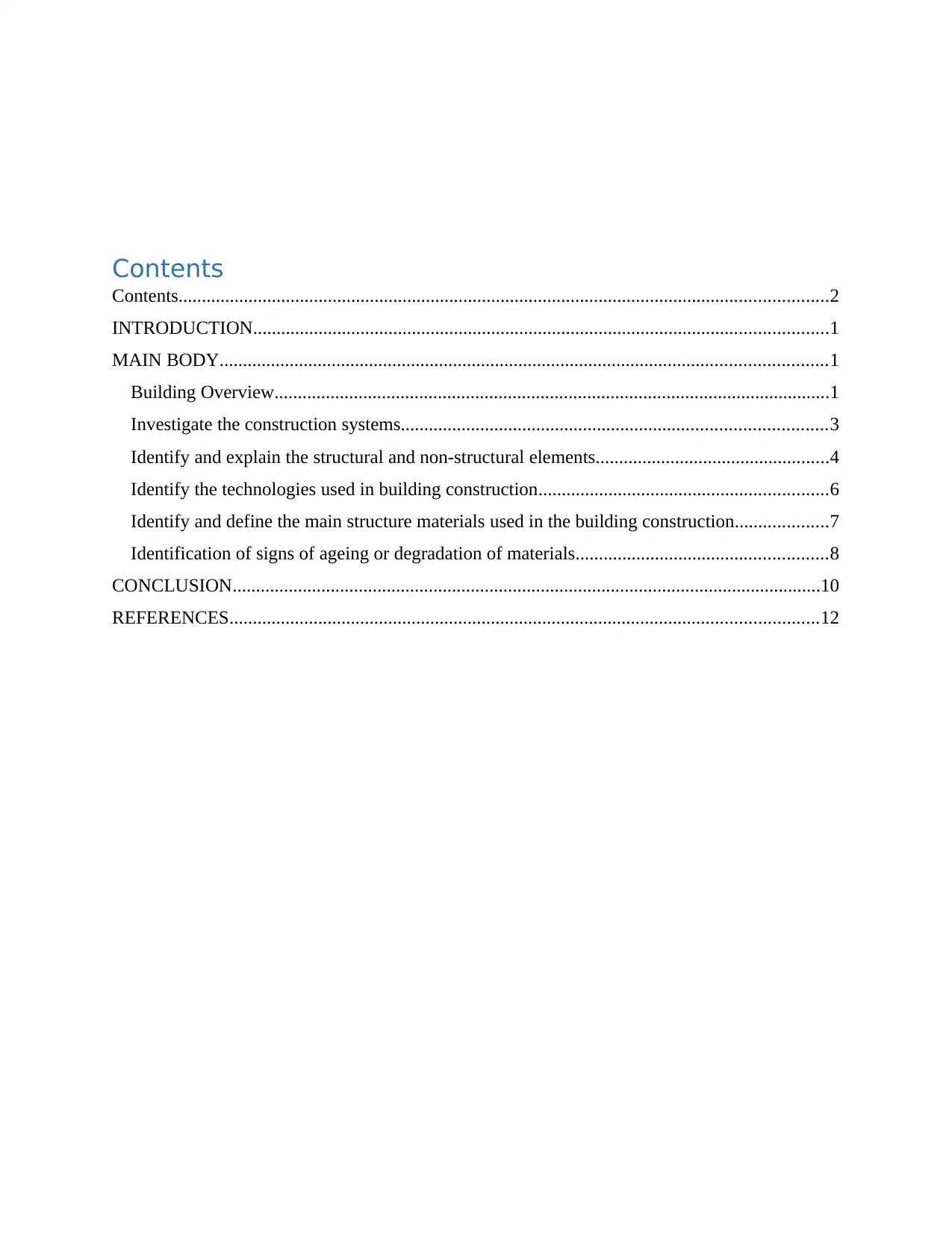
Contents
Contents...........................................................................................................................................2
INTRODUCTION...........................................................................................................................1
MAIN BODY..................................................................................................................................1
Building Overview.......................................................................................................................1
Investigate the construction systems...........................................................................................3
Identify and explain the structural and non-structural elements..................................................4
Identify the technologies used in building construction..............................................................6
Identify and define the main structure materials used in the building construction....................7
Identification of signs of ageing or degradation of materials......................................................8
CONCLUSION..............................................................................................................................10
REFERENCES..............................................................................................................................12
Contents...........................................................................................................................................2
INTRODUCTION...........................................................................................................................1
MAIN BODY..................................................................................................................................1
Building Overview.......................................................................................................................1
Investigate the construction systems...........................................................................................3
Identify and explain the structural and non-structural elements..................................................4
Identify the technologies used in building construction..............................................................6
Identify and define the main structure materials used in the building construction....................7
Identification of signs of ageing or degradation of materials......................................................8
CONCLUSION..............................................................................................................................10
REFERENCES..............................................................................................................................12

⊘ This is a preview!⊘
Do you want full access?
Subscribe today to unlock all pages.

Trusted by 1+ million students worldwide
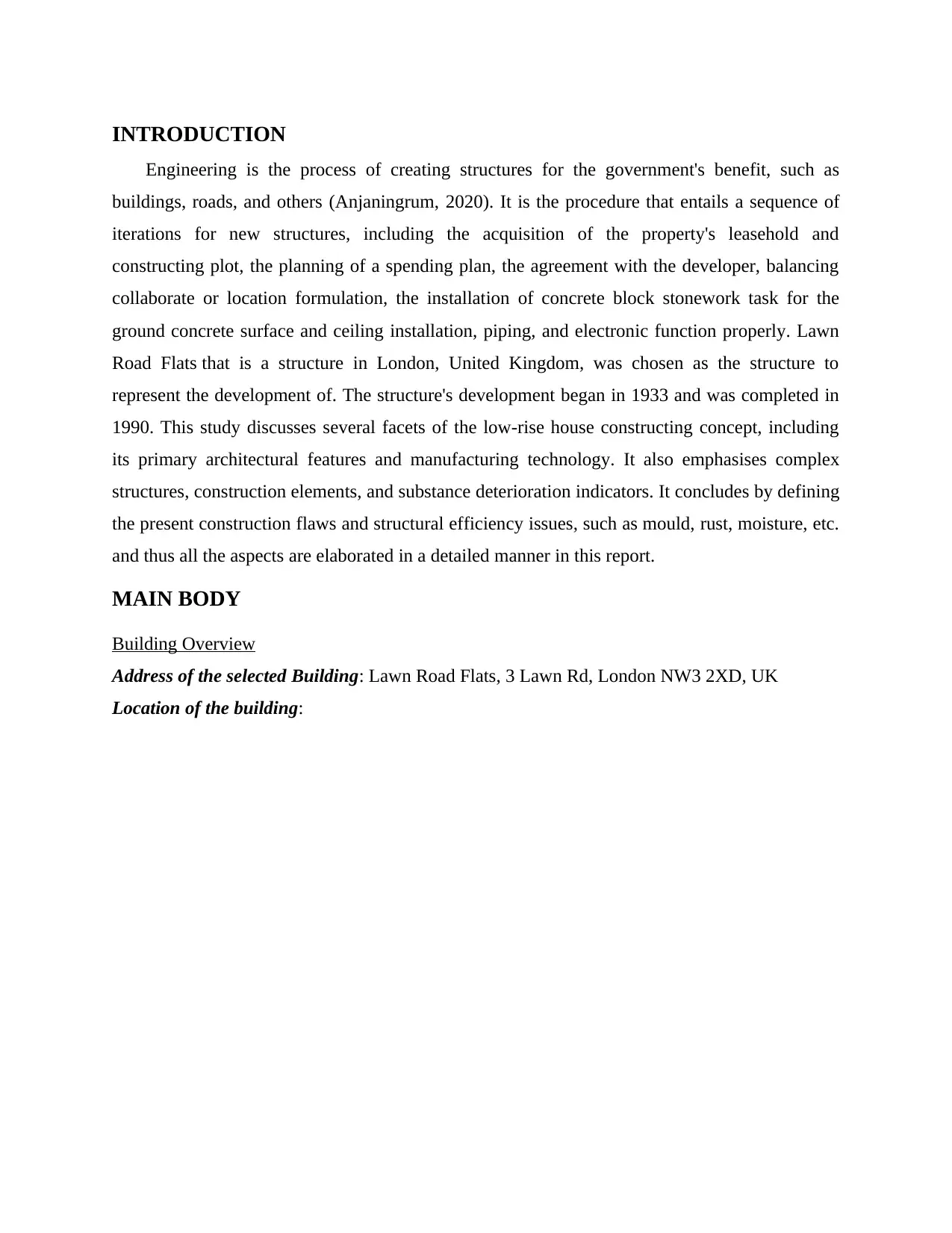
INTRODUCTION
Engineering is the process of creating structures for the government's benefit, such as
buildings, roads, and others (Anjaningrum, 2020). It is the procedure that entails a sequence of
iterations for new structures, including the acquisition of the property's leasehold and
constructing plot, the planning of a spending plan, the agreement with the developer, balancing
collaborate or location formulation, the installation of concrete block stonework task for the
ground concrete surface and ceiling installation, piping, and electronic function properly. Lawn
Road Flats that is a structure in London, United Kingdom, was chosen as the structure to
represent the development of. The structure's development began in 1933 and was completed in
1990. This study discusses several facets of the low-rise house constructing concept, including
its primary architectural features and manufacturing technology. It also emphasises complex
structures, construction elements, and substance deterioration indicators. It concludes by defining
the present construction flaws and structural efficiency issues, such as mould, rust, moisture, etc.
and thus all the aspects are elaborated in a detailed manner in this report.
MAIN BODY
Building Overview
Address of the selected Building: Lawn Road Flats, 3 Lawn Rd, London NW3 2XD, UK
Location of the building:
Engineering is the process of creating structures for the government's benefit, such as
buildings, roads, and others (Anjaningrum, 2020). It is the procedure that entails a sequence of
iterations for new structures, including the acquisition of the property's leasehold and
constructing plot, the planning of a spending plan, the agreement with the developer, balancing
collaborate or location formulation, the installation of concrete block stonework task for the
ground concrete surface and ceiling installation, piping, and electronic function properly. Lawn
Road Flats that is a structure in London, United Kingdom, was chosen as the structure to
represent the development of. The structure's development began in 1933 and was completed in
1990. This study discusses several facets of the low-rise house constructing concept, including
its primary architectural features and manufacturing technology. It also emphasises complex
structures, construction elements, and substance deterioration indicators. It concludes by defining
the present construction flaws and structural efficiency issues, such as mould, rust, moisture, etc.
and thus all the aspects are elaborated in a detailed manner in this report.
MAIN BODY
Building Overview
Address of the selected Building: Lawn Road Flats, 3 Lawn Rd, London NW3 2XD, UK
Location of the building:
Paraphrase This Document
Need a fresh take? Get an instant paraphrase of this document with our AI Paraphraser
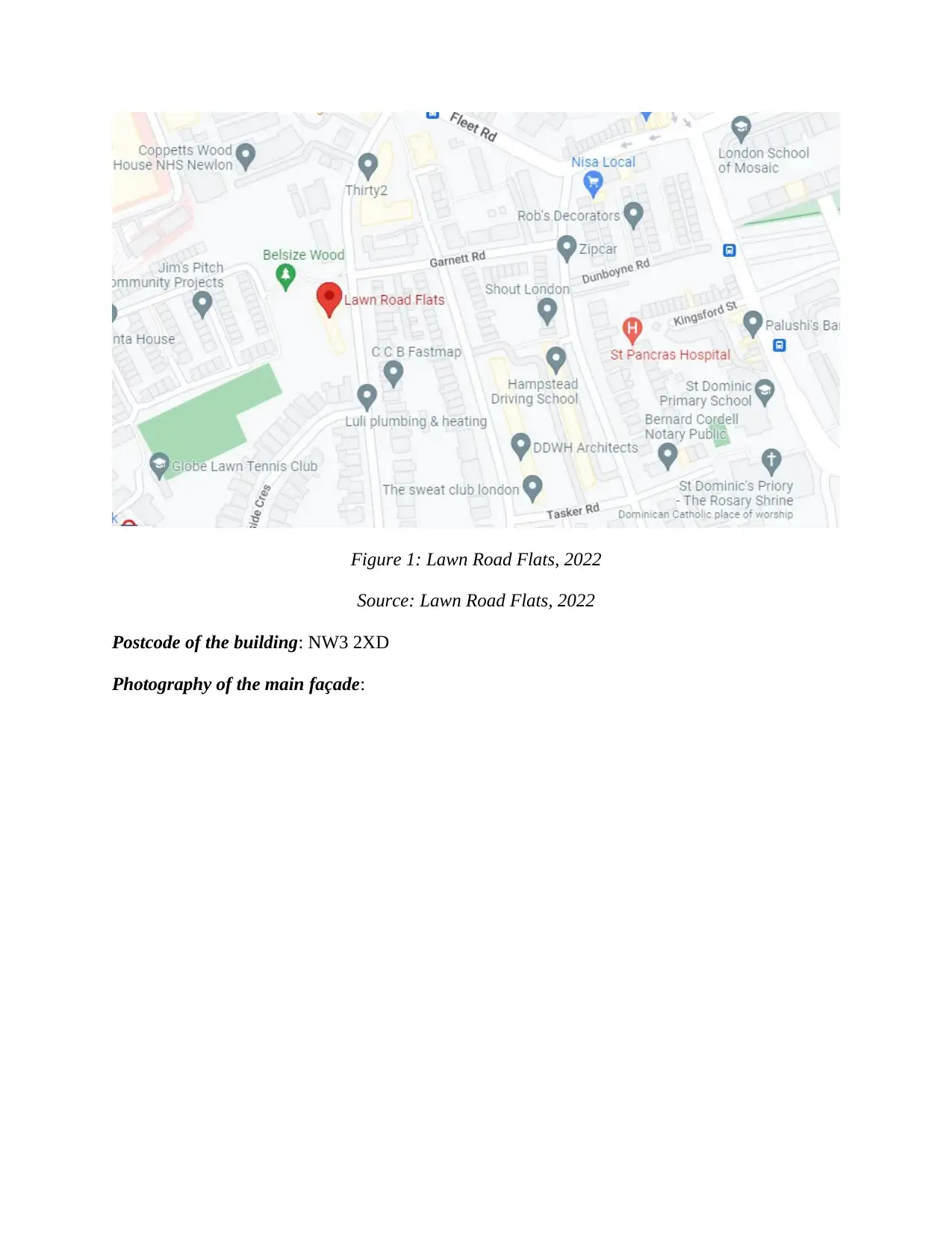
Figure 1: Lawn Road Flats, 2022
Source: Lawn Road Flats, 2022
Postcode of the building: NW3 2XD
Photography of the main façade:
Source: Lawn Road Flats, 2022
Postcode of the building: NW3 2XD
Photography of the main façade:
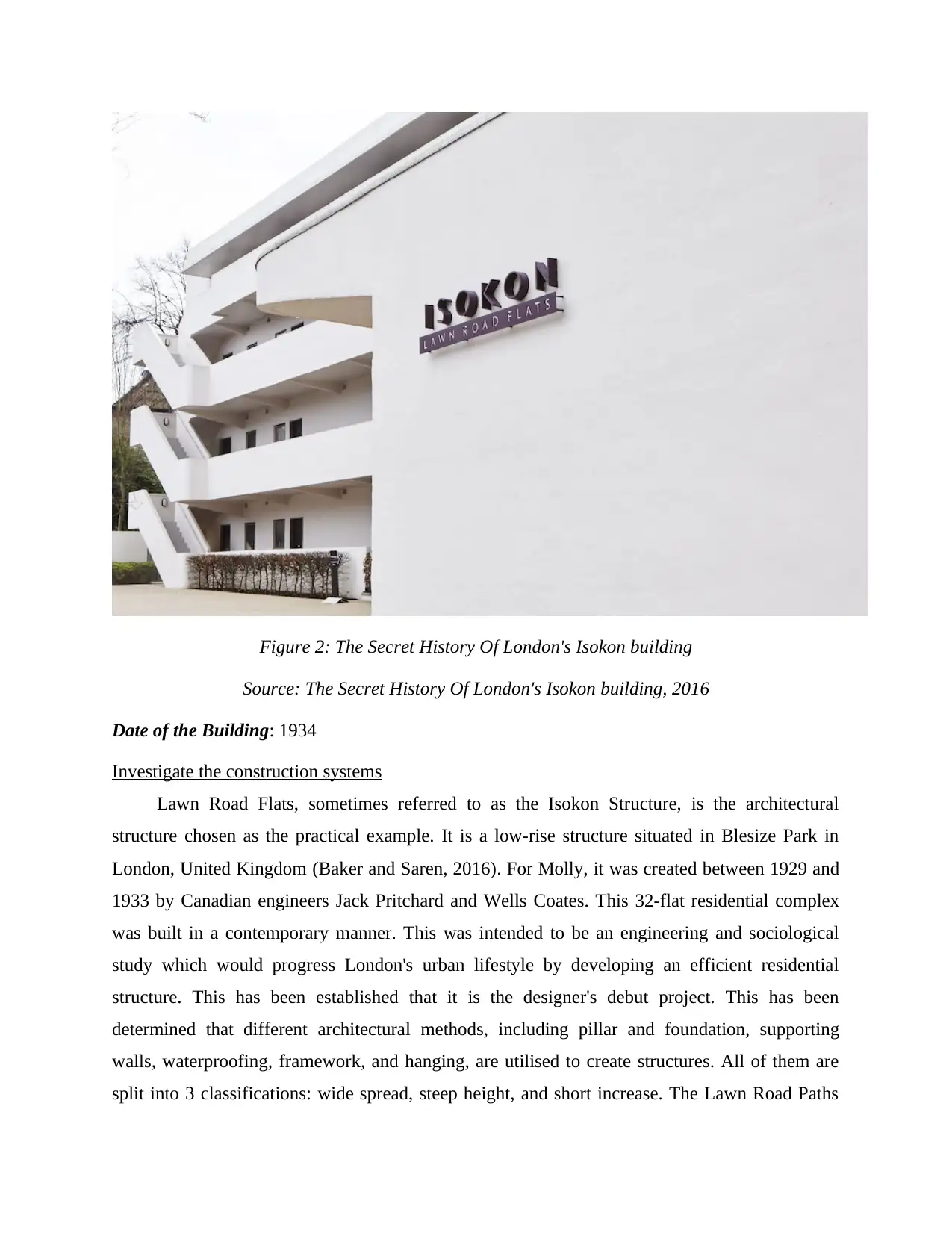
Figure 2: The Secret History Of London's Isokon building
Source: The Secret History Of London's Isokon building, 2016
Date of the Building: 1934
Investigate the construction systems
Lawn Road Flats, sometimes referred to as the Isokon Structure, is the architectural
structure chosen as the practical example. It is a low-rise structure situated in Blesize Park in
London, United Kingdom (Baker and Saren, 2016). For Molly, it was created between 1929 and
1933 by Canadian engineers Jack Pritchard and Wells Coates. This 32-flat residential complex
was built in a contemporary manner. This was intended to be an engineering and sociological
study which would progress London's urban lifestyle by developing an efficient residential
structure. This has been established that it is the designer's debut project. This has been
determined that different architectural methods, including pillar and foundation, supporting
walls, waterproofing, framework, and hanging, are utilised to create structures. All of them are
split into 3 classifications: wide spread, steep height, and short increase. The Lawn Road Paths
Source: The Secret History Of London's Isokon building, 2016
Date of the Building: 1934
Investigate the construction systems
Lawn Road Flats, sometimes referred to as the Isokon Structure, is the architectural
structure chosen as the practical example. It is a low-rise structure situated in Blesize Park in
London, United Kingdom (Baker and Saren, 2016). For Molly, it was created between 1929 and
1933 by Canadian engineers Jack Pritchard and Wells Coates. This 32-flat residential complex
was built in a contemporary manner. This was intended to be an engineering and sociological
study which would progress London's urban lifestyle by developing an efficient residential
structure. This has been established that it is the designer's debut project. This has been
determined that different architectural methods, including pillar and foundation, supporting
walls, waterproofing, framework, and hanging, are utilised to create structures. All of them are
split into 3 classifications: wide spread, steep height, and short increase. The Lawn Road Paths
⊘ This is a preview!⊘
Do you want full access?
Subscribe today to unlock all pages.

Trusted by 1+ million students worldwide
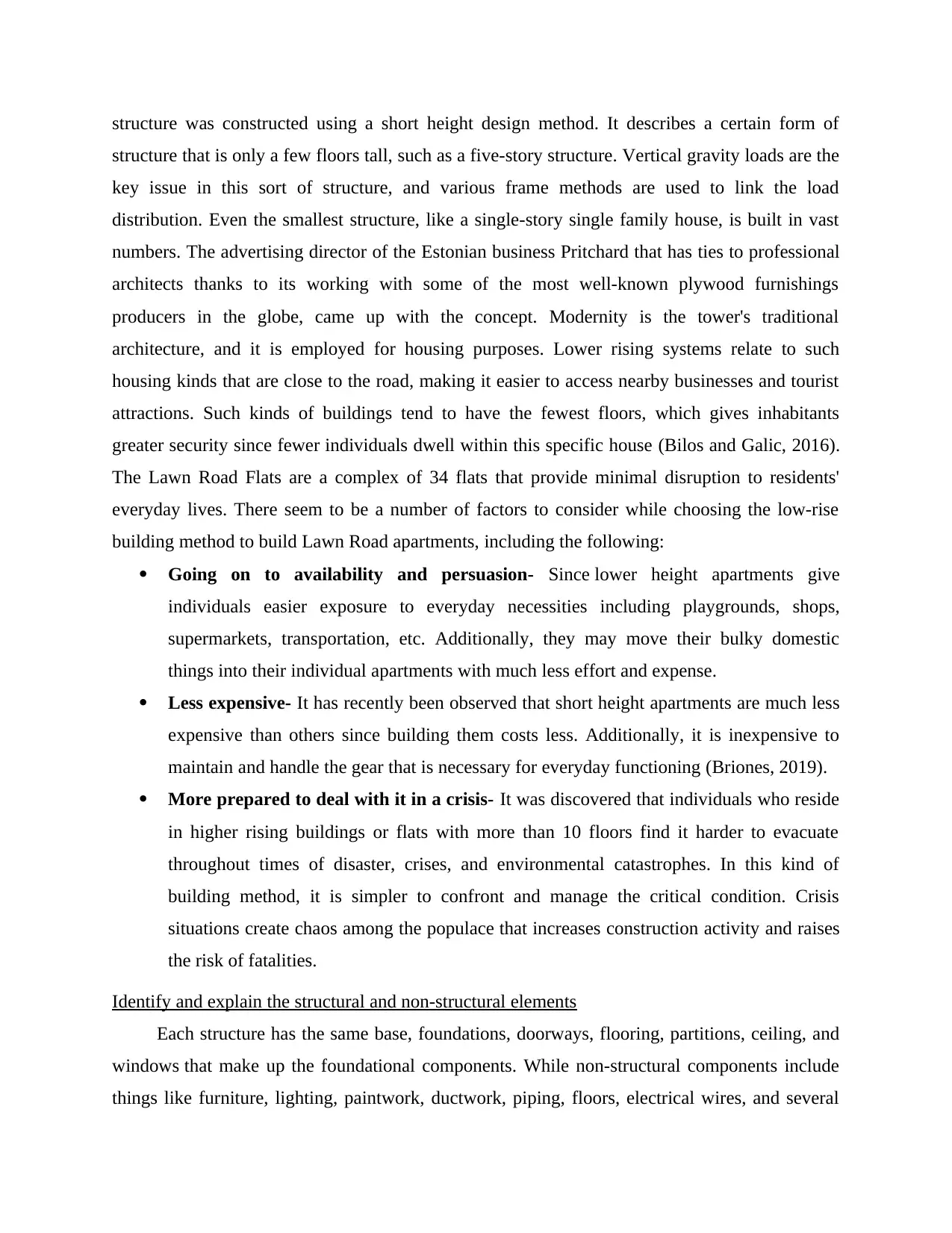
structure was constructed using a short height design method. It describes a certain form of
structure that is only a few floors tall, such as a five-story structure. Vertical gravity loads are the
key issue in this sort of structure, and various frame methods are used to link the load
distribution. Even the smallest structure, like a single-story single family house, is built in vast
numbers. The advertising director of the Estonian business Pritchard that has ties to professional
architects thanks to its working with some of the most well-known plywood furnishings
producers in the globe, came up with the concept. Modernity is the tower's traditional
architecture, and it is employed for housing purposes. Lower rising systems relate to such
housing kinds that are close to the road, making it easier to access nearby businesses and tourist
attractions. Such kinds of buildings tend to have the fewest floors, which gives inhabitants
greater security since fewer individuals dwell within this specific house (Bilos and Galic, 2016).
The Lawn Road Flats are a complex of 34 flats that provide minimal disruption to residents'
everyday lives. There seem to be a number of factors to consider while choosing the low-rise
building method to build Lawn Road apartments, including the following:
Going on to availability and persuasion- Since lower height apartments give
individuals easier exposure to everyday necessities including playgrounds, shops,
supermarkets, transportation, etc. Additionally, they may move their bulky domestic
things into their individual apartments with much less effort and expense.
Less expensive- It has recently been observed that short height apartments are much less
expensive than others since building them costs less. Additionally, it is inexpensive to
maintain and handle the gear that is necessary for everyday functioning (Briones, 2019).
More prepared to deal with it in a crisis- It was discovered that individuals who reside
in higher rising buildings or flats with more than 10 floors find it harder to evacuate
throughout times of disaster, crises, and environmental catastrophes. In this kind of
building method, it is simpler to confront and manage the critical condition. Crisis
situations create chaos among the populace that increases construction activity and raises
the risk of fatalities.
Identify and explain the structural and non-structural elements
Each structure has the same base, foundations, doorways, flooring, partitions, ceiling, and
windows that make up the foundational components. While non-structural components include
things like furniture, lighting, paintwork, ductwork, piping, floors, electrical wires, and several
structure that is only a few floors tall, such as a five-story structure. Vertical gravity loads are the
key issue in this sort of structure, and various frame methods are used to link the load
distribution. Even the smallest structure, like a single-story single family house, is built in vast
numbers. The advertising director of the Estonian business Pritchard that has ties to professional
architects thanks to its working with some of the most well-known plywood furnishings
producers in the globe, came up with the concept. Modernity is the tower's traditional
architecture, and it is employed for housing purposes. Lower rising systems relate to such
housing kinds that are close to the road, making it easier to access nearby businesses and tourist
attractions. Such kinds of buildings tend to have the fewest floors, which gives inhabitants
greater security since fewer individuals dwell within this specific house (Bilos and Galic, 2016).
The Lawn Road Flats are a complex of 34 flats that provide minimal disruption to residents'
everyday lives. There seem to be a number of factors to consider while choosing the low-rise
building method to build Lawn Road apartments, including the following:
Going on to availability and persuasion- Since lower height apartments give
individuals easier exposure to everyday necessities including playgrounds, shops,
supermarkets, transportation, etc. Additionally, they may move their bulky domestic
things into their individual apartments with much less effort and expense.
Less expensive- It has recently been observed that short height apartments are much less
expensive than others since building them costs less. Additionally, it is inexpensive to
maintain and handle the gear that is necessary for everyday functioning (Briones, 2019).
More prepared to deal with it in a crisis- It was discovered that individuals who reside
in higher rising buildings or flats with more than 10 floors find it harder to evacuate
throughout times of disaster, crises, and environmental catastrophes. In this kind of
building method, it is simpler to confront and manage the critical condition. Crisis
situations create chaos among the populace that increases construction activity and raises
the risk of fatalities.
Identify and explain the structural and non-structural elements
Each structure has the same base, foundations, doorways, flooring, partitions, ceiling, and
windows that make up the foundational components. While non-structural components include
things like furniture, lighting, paintwork, ductwork, piping, floors, electrical wires, and several
Paraphrase This Document
Need a fresh take? Get an instant paraphrase of this document with our AI Paraphraser
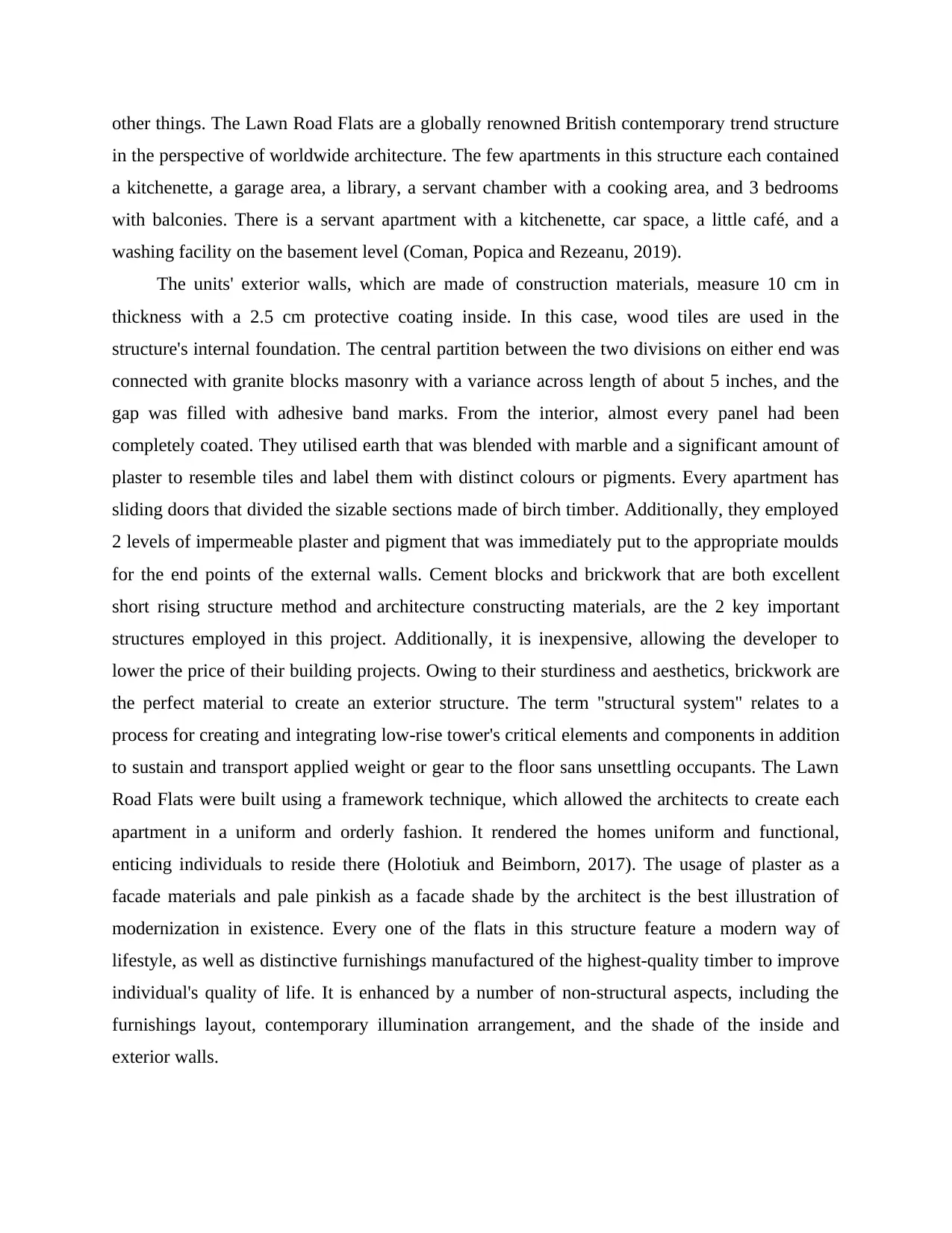
other things. The Lawn Road Flats are a globally renowned British contemporary trend structure
in the perspective of worldwide architecture. The few apartments in this structure each contained
a kitchenette, a garage area, a library, a servant chamber with a cooking area, and 3 bedrooms
with balconies. There is a servant apartment with a kitchenette, car space, a little café, and a
washing facility on the basement level (Coman, Popica and Rezeanu, 2019).
The units' exterior walls, which are made of construction materials, measure 10 cm in
thickness with a 2.5 cm protective coating inside. In this case, wood tiles are used in the
structure's internal foundation. The central partition between the two divisions on either end was
connected with granite blocks masonry with a variance across length of about 5 inches, and the
gap was filled with adhesive band marks. From the interior, almost every panel had been
completely coated. They utilised earth that was blended with marble and a significant amount of
plaster to resemble tiles and label them with distinct colours or pigments. Every apartment has
sliding doors that divided the sizable sections made of birch timber. Additionally, they employed
2 levels of impermeable plaster and pigment that was immediately put to the appropriate moulds
for the end points of the external walls. Cement blocks and brickwork that are both excellent
short rising structure method and architecture constructing materials, are the 2 key important
structures employed in this project. Additionally, it is inexpensive, allowing the developer to
lower the price of their building projects. Owing to their sturdiness and aesthetics, brickwork are
the perfect material to create an exterior structure. The term "structural system" relates to a
process for creating and integrating low-rise tower's critical elements and components in addition
to sustain and transport applied weight or gear to the floor sans unsettling occupants. The Lawn
Road Flats were built using a framework technique, which allowed the architects to create each
apartment in a uniform and orderly fashion. It rendered the homes uniform and functional,
enticing individuals to reside there (Holotiuk and Beimborn, 2017). The usage of plaster as a
facade materials and pale pinkish as a facade shade by the architect is the best illustration of
modernization in existence. Every one of the flats in this structure feature a modern way of
lifestyle, as well as distinctive furnishings manufactured of the highest-quality timber to improve
individual's quality of life. It is enhanced by a number of non-structural aspects, including the
furnishings layout, contemporary illumination arrangement, and the shade of the inside and
exterior walls.
in the perspective of worldwide architecture. The few apartments in this structure each contained
a kitchenette, a garage area, a library, a servant chamber with a cooking area, and 3 bedrooms
with balconies. There is a servant apartment with a kitchenette, car space, a little café, and a
washing facility on the basement level (Coman, Popica and Rezeanu, 2019).
The units' exterior walls, which are made of construction materials, measure 10 cm in
thickness with a 2.5 cm protective coating inside. In this case, wood tiles are used in the
structure's internal foundation. The central partition between the two divisions on either end was
connected with granite blocks masonry with a variance across length of about 5 inches, and the
gap was filled with adhesive band marks. From the interior, almost every panel had been
completely coated. They utilised earth that was blended with marble and a significant amount of
plaster to resemble tiles and label them with distinct colours or pigments. Every apartment has
sliding doors that divided the sizable sections made of birch timber. Additionally, they employed
2 levels of impermeable plaster and pigment that was immediately put to the appropriate moulds
for the end points of the external walls. Cement blocks and brickwork that are both excellent
short rising structure method and architecture constructing materials, are the 2 key important
structures employed in this project. Additionally, it is inexpensive, allowing the developer to
lower the price of their building projects. Owing to their sturdiness and aesthetics, brickwork are
the perfect material to create an exterior structure. The term "structural system" relates to a
process for creating and integrating low-rise tower's critical elements and components in addition
to sustain and transport applied weight or gear to the floor sans unsettling occupants. The Lawn
Road Flats were built using a framework technique, which allowed the architects to create each
apartment in a uniform and orderly fashion. It rendered the homes uniform and functional,
enticing individuals to reside there (Holotiuk and Beimborn, 2017). The usage of plaster as a
facade materials and pale pinkish as a facade shade by the architect is the best illustration of
modernization in existence. Every one of the flats in this structure feature a modern way of
lifestyle, as well as distinctive furnishings manufactured of the highest-quality timber to improve
individual's quality of life. It is enhanced by a number of non-structural aspects, including the
furnishings layout, contemporary illumination arrangement, and the shade of the inside and
exterior walls.
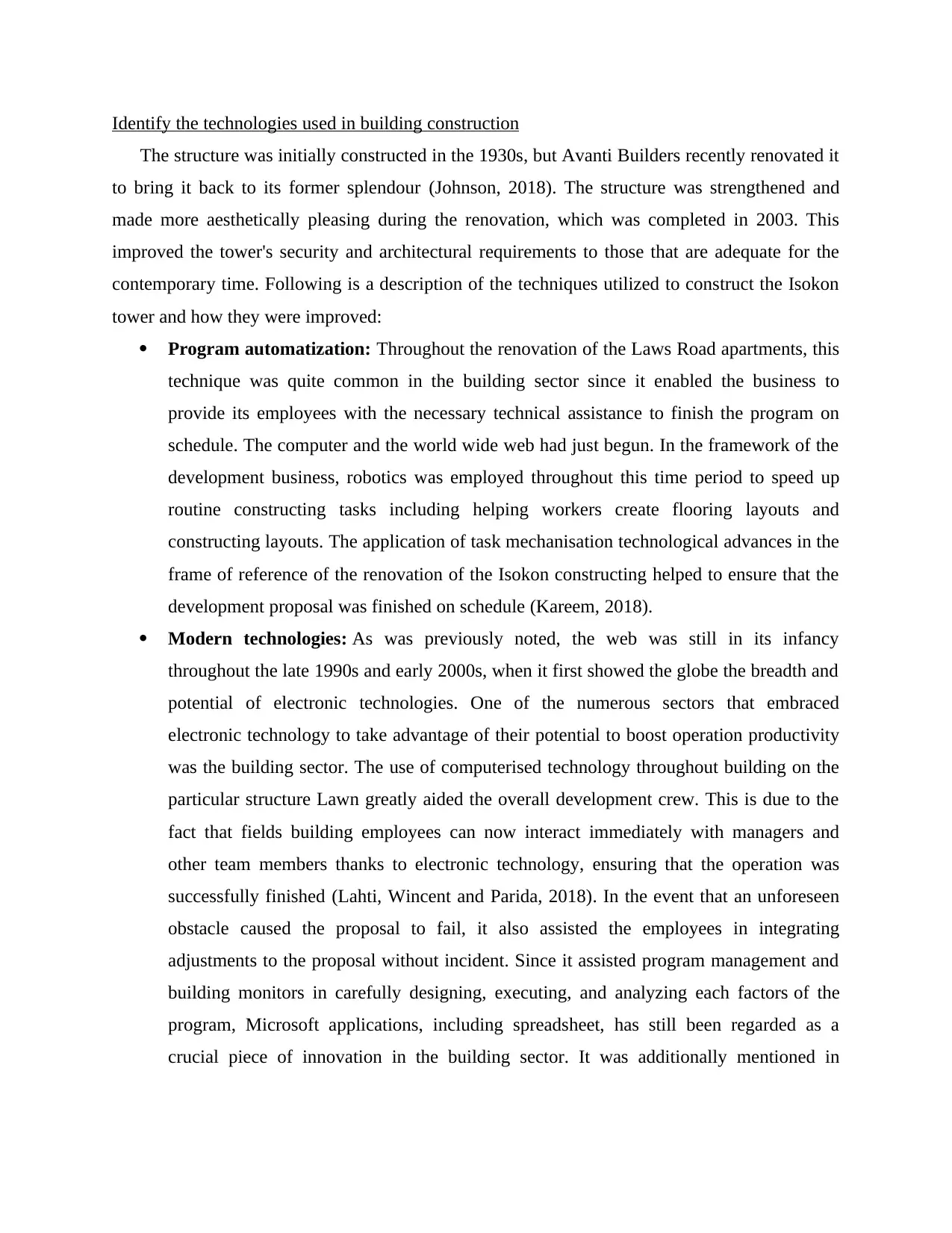
Identify the technologies used in building construction
The structure was initially constructed in the 1930s, but Avanti Builders recently renovated it
to bring it back to its former splendour (Johnson, 2018). The structure was strengthened and
made more aesthetically pleasing during the renovation, which was completed in 2003. This
improved the tower's security and architectural requirements to those that are adequate for the
contemporary time. Following is a description of the techniques utilized to construct the Isokon
tower and how they were improved:
Program automatization: Throughout the renovation of the Laws Road apartments, this
technique was quite common in the building sector since it enabled the business to
provide its employees with the necessary technical assistance to finish the program on
schedule. The computer and the world wide web had just begun. In the framework of the
development business, robotics was employed throughout this time period to speed up
routine constructing tasks including helping workers create flooring layouts and
constructing layouts. The application of task mechanisation technological advances in the
frame of reference of the renovation of the Isokon constructing helped to ensure that the
development proposal was finished on schedule (Kareem, 2018).
Modern technologies: As was previously noted, the web was still in its infancy
throughout the late 1990s and early 2000s, when it first showed the globe the breadth and
potential of electronic technologies. One of the numerous sectors that embraced
electronic technology to take advantage of their potential to boost operation productivity
was the building sector. The use of computerised technology throughout building on the
particular structure Lawn greatly aided the overall development crew. This is due to the
fact that fields building employees can now interact immediately with managers and
other team members thanks to electronic technology, ensuring that the operation was
successfully finished (Lahti, Wincent and Parida, 2018). In the event that an unforeseen
obstacle caused the proposal to fail, it also assisted the employees in integrating
adjustments to the proposal without incident. Since it assisted program management and
building monitors in carefully designing, executing, and analyzing each factors of the
program, Microsoft applications, including spreadsheet, has still been regarded as a
crucial piece of innovation in the building sector. It was additionally mentioned in
The structure was initially constructed in the 1930s, but Avanti Builders recently renovated it
to bring it back to its former splendour (Johnson, 2018). The structure was strengthened and
made more aesthetically pleasing during the renovation, which was completed in 2003. This
improved the tower's security and architectural requirements to those that are adequate for the
contemporary time. Following is a description of the techniques utilized to construct the Isokon
tower and how they were improved:
Program automatization: Throughout the renovation of the Laws Road apartments, this
technique was quite common in the building sector since it enabled the business to
provide its employees with the necessary technical assistance to finish the program on
schedule. The computer and the world wide web had just begun. In the framework of the
development business, robotics was employed throughout this time period to speed up
routine constructing tasks including helping workers create flooring layouts and
constructing layouts. The application of task mechanisation technological advances in the
frame of reference of the renovation of the Isokon constructing helped to ensure that the
development proposal was finished on schedule (Kareem, 2018).
Modern technologies: As was previously noted, the web was still in its infancy
throughout the late 1990s and early 2000s, when it first showed the globe the breadth and
potential of electronic technologies. One of the numerous sectors that embraced
electronic technology to take advantage of their potential to boost operation productivity
was the building sector. The use of computerised technology throughout building on the
particular structure Lawn greatly aided the overall development crew. This is due to the
fact that fields building employees can now interact immediately with managers and
other team members thanks to electronic technology, ensuring that the operation was
successfully finished (Lahti, Wincent and Parida, 2018). In the event that an unforeseen
obstacle caused the proposal to fail, it also assisted the employees in integrating
adjustments to the proposal without incident. Since it assisted program management and
building monitors in carefully designing, executing, and analyzing each factors of the
program, Microsoft applications, including spreadsheet, has still been regarded as a
crucial piece of innovation in the building sector. It was additionally mentioned in
⊘ This is a preview!⊘
Do you want full access?
Subscribe today to unlock all pages.

Trusted by 1+ million students worldwide
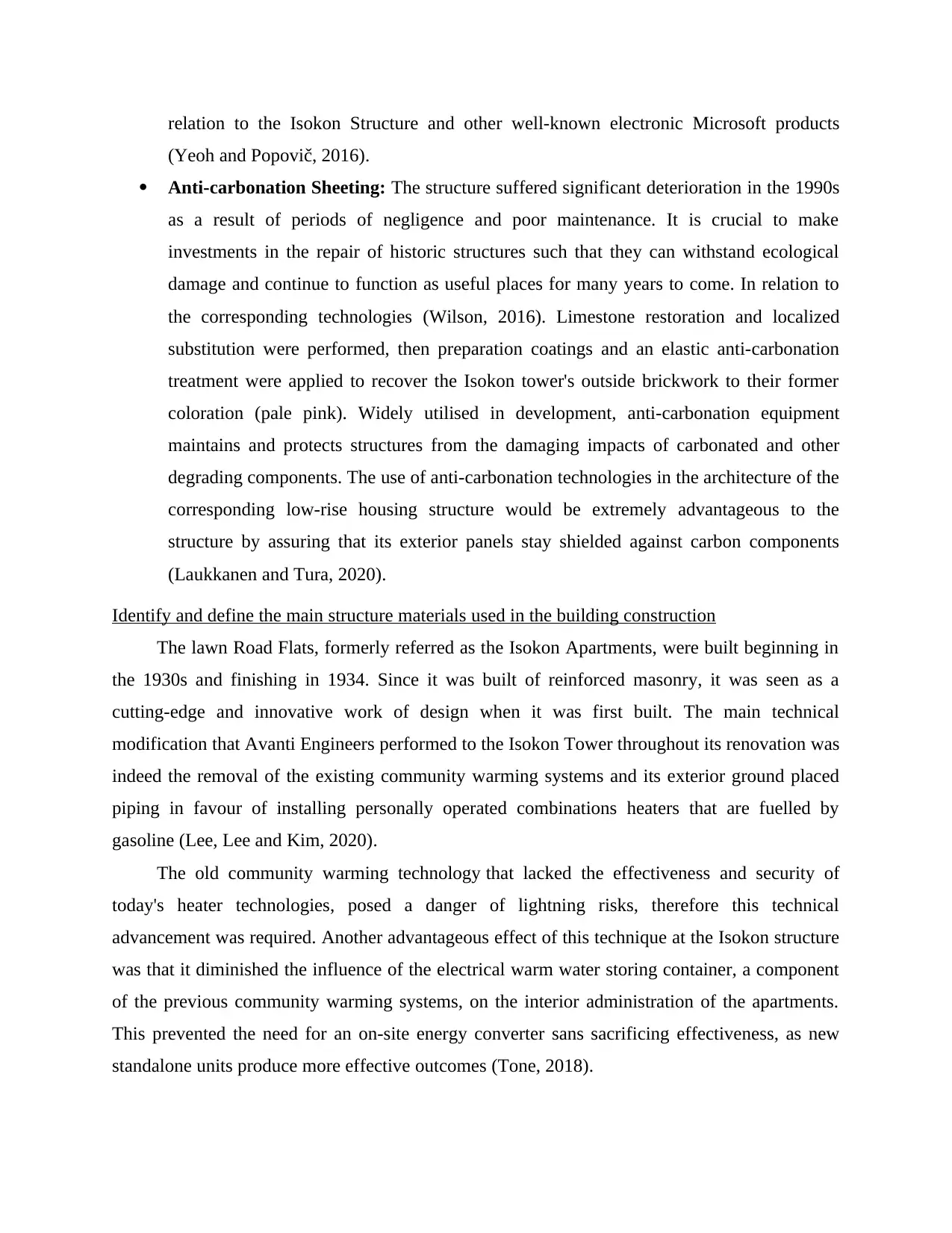
relation to the Isokon Structure and other well-known electronic Microsoft products
(Yeoh and Popovič, 2016).
Anti-carbonation Sheeting: The structure suffered significant deterioration in the 1990s
as a result of periods of negligence and poor maintenance. It is crucial to make
investments in the repair of historic structures such that they can withstand ecological
damage and continue to function as useful places for many years to come. In relation to
the corresponding technologies (Wilson, 2016). Limestone restoration and localized
substitution were performed, then preparation coatings and an elastic anti-carbonation
treatment were applied to recover the Isokon tower's outside brickwork to their former
coloration (pale pink). Widely utilised in development, anti-carbonation equipment
maintains and protects structures from the damaging impacts of carbonated and other
degrading components. The use of anti-carbonation technologies in the architecture of the
corresponding low-rise housing structure would be extremely advantageous to the
structure by assuring that its exterior panels stay shielded against carbon components
(Laukkanen and Tura, 2020).
Identify and define the main structure materials used in the building construction
The lawn Road Flats, formerly referred as the Isokon Apartments, were built beginning in
the 1930s and finishing in 1934. Since it was built of reinforced masonry, it was seen as a
cutting-edge and innovative work of design when it was first built. The main technical
modification that Avanti Engineers performed to the Isokon Tower throughout its renovation was
indeed the removal of the existing community warming systems and its exterior ground placed
piping in favour of installing personally operated combinations heaters that are fuelled by
gasoline (Lee, Lee and Kim, 2020).
The old community warming technology that lacked the effectiveness and security of
today's heater technologies, posed a danger of lightning risks, therefore this technical
advancement was required. Another advantageous effect of this technique at the Isokon structure
was that it diminished the influence of the electrical warm water storing container, a component
of the previous community warming systems, on the interior administration of the apartments.
This prevented the need for an on-site energy converter sans sacrificing effectiveness, as new
standalone units produce more effective outcomes (Tone, 2018).
(Yeoh and Popovič, 2016).
Anti-carbonation Sheeting: The structure suffered significant deterioration in the 1990s
as a result of periods of negligence and poor maintenance. It is crucial to make
investments in the repair of historic structures such that they can withstand ecological
damage and continue to function as useful places for many years to come. In relation to
the corresponding technologies (Wilson, 2016). Limestone restoration and localized
substitution were performed, then preparation coatings and an elastic anti-carbonation
treatment were applied to recover the Isokon tower's outside brickwork to their former
coloration (pale pink). Widely utilised in development, anti-carbonation equipment
maintains and protects structures from the damaging impacts of carbonated and other
degrading components. The use of anti-carbonation technologies in the architecture of the
corresponding low-rise housing structure would be extremely advantageous to the
structure by assuring that its exterior panels stay shielded against carbon components
(Laukkanen and Tura, 2020).
Identify and define the main structure materials used in the building construction
The lawn Road Flats, formerly referred as the Isokon Apartments, were built beginning in
the 1930s and finishing in 1934. Since it was built of reinforced masonry, it was seen as a
cutting-edge and innovative work of design when it was first built. The main technical
modification that Avanti Engineers performed to the Isokon Tower throughout its renovation was
indeed the removal of the existing community warming systems and its exterior ground placed
piping in favour of installing personally operated combinations heaters that are fuelled by
gasoline (Lee, Lee and Kim, 2020).
The old community warming technology that lacked the effectiveness and security of
today's heater technologies, posed a danger of lightning risks, therefore this technical
advancement was required. Another advantageous effect of this technique at the Isokon structure
was that it diminished the influence of the electrical warm water storing container, a component
of the previous community warming systems, on the interior administration of the apartments.
This prevented the need for an on-site energy converter sans sacrificing effectiveness, as new
standalone units produce more effective outcomes (Tone, 2018).
Paraphrase This Document
Need a fresh take? Get an instant paraphrase of this document with our AI Paraphraser
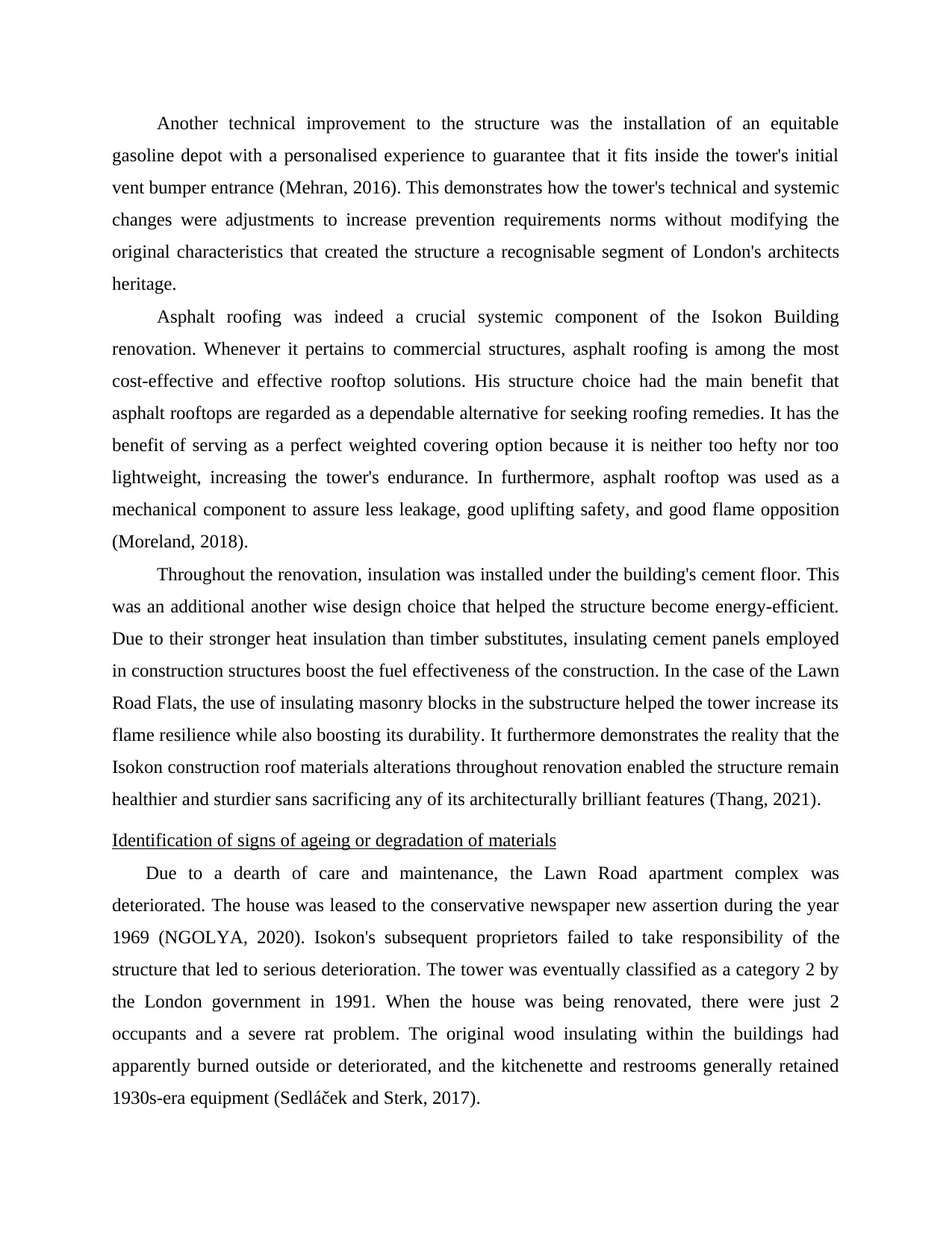
Another technical improvement to the structure was the installation of an equitable
gasoline depot with a personalised experience to guarantee that it fits inside the tower's initial
vent bumper entrance (Mehran, 2016). This demonstrates how the tower's technical and systemic
changes were adjustments to increase prevention requirements norms without modifying the
original characteristics that created the structure a recognisable segment of London's architects
heritage.
Asphalt roofing was indeed a crucial systemic component of the Isokon Building
renovation. Whenever it pertains to commercial structures, asphalt roofing is among the most
cost-effective and effective rooftop solutions. His structure choice had the main benefit that
asphalt rooftops are regarded as a dependable alternative for seeking roofing remedies. It has the
benefit of serving as a perfect weighted covering option because it is neither too hefty nor too
lightweight, increasing the tower's endurance. In furthermore, asphalt rooftop was used as a
mechanical component to assure less leakage, good uplifting safety, and good flame opposition
(Moreland, 2018).
Throughout the renovation, insulation was installed under the building's cement floor. This
was an additional another wise design choice that helped the structure become energy-efficient.
Due to their stronger heat insulation than timber substitutes, insulating cement panels employed
in construction structures boost the fuel effectiveness of the construction. In the case of the Lawn
Road Flats, the use of insulating masonry blocks in the substructure helped the tower increase its
flame resilience while also boosting its durability. It furthermore demonstrates the reality that the
Isokon construction roof materials alterations throughout renovation enabled the structure remain
healthier and sturdier sans sacrificing any of its architecturally brilliant features (Thang, 2021).
Identification of signs of ageing or degradation of materials
Due to a dearth of care and maintenance, the Lawn Road apartment complex was
deteriorated. The house was leased to the conservative newspaper new assertion during the year
1969 (NGOLYA, 2020). Isokon's subsequent proprietors failed to take responsibility of the
structure that led to serious deterioration. The tower was eventually classified as a category 2 by
the London government in 1991. When the house was being renovated, there were just 2
occupants and a severe rat problem. The original wood insulating within the buildings had
apparently burned outside or deteriorated, and the kitchenette and restrooms generally retained
1930s-era equipment (Sedláček and Sterk, 2017).
gasoline depot with a personalised experience to guarantee that it fits inside the tower's initial
vent bumper entrance (Mehran, 2016). This demonstrates how the tower's technical and systemic
changes were adjustments to increase prevention requirements norms without modifying the
original characteristics that created the structure a recognisable segment of London's architects
heritage.
Asphalt roofing was indeed a crucial systemic component of the Isokon Building
renovation. Whenever it pertains to commercial structures, asphalt roofing is among the most
cost-effective and effective rooftop solutions. His structure choice had the main benefit that
asphalt rooftops are regarded as a dependable alternative for seeking roofing remedies. It has the
benefit of serving as a perfect weighted covering option because it is neither too hefty nor too
lightweight, increasing the tower's endurance. In furthermore, asphalt rooftop was used as a
mechanical component to assure less leakage, good uplifting safety, and good flame opposition
(Moreland, 2018).
Throughout the renovation, insulation was installed under the building's cement floor. This
was an additional another wise design choice that helped the structure become energy-efficient.
Due to their stronger heat insulation than timber substitutes, insulating cement panels employed
in construction structures boost the fuel effectiveness of the construction. In the case of the Lawn
Road Flats, the use of insulating masonry blocks in the substructure helped the tower increase its
flame resilience while also boosting its durability. It furthermore demonstrates the reality that the
Isokon construction roof materials alterations throughout renovation enabled the structure remain
healthier and sturdier sans sacrificing any of its architecturally brilliant features (Thang, 2021).
Identification of signs of ageing or degradation of materials
Due to a dearth of care and maintenance, the Lawn Road apartment complex was
deteriorated. The house was leased to the conservative newspaper new assertion during the year
1969 (NGOLYA, 2020). Isokon's subsequent proprietors failed to take responsibility of the
structure that led to serious deterioration. The tower was eventually classified as a category 2 by
the London government in 1991. When the house was being renovated, there were just 2
occupants and a severe rat problem. The original wood insulating within the buildings had
apparently burned outside or deteriorated, and the kitchenette and restrooms generally retained
1930s-era equipment (Sedláček and Sterk, 2017).
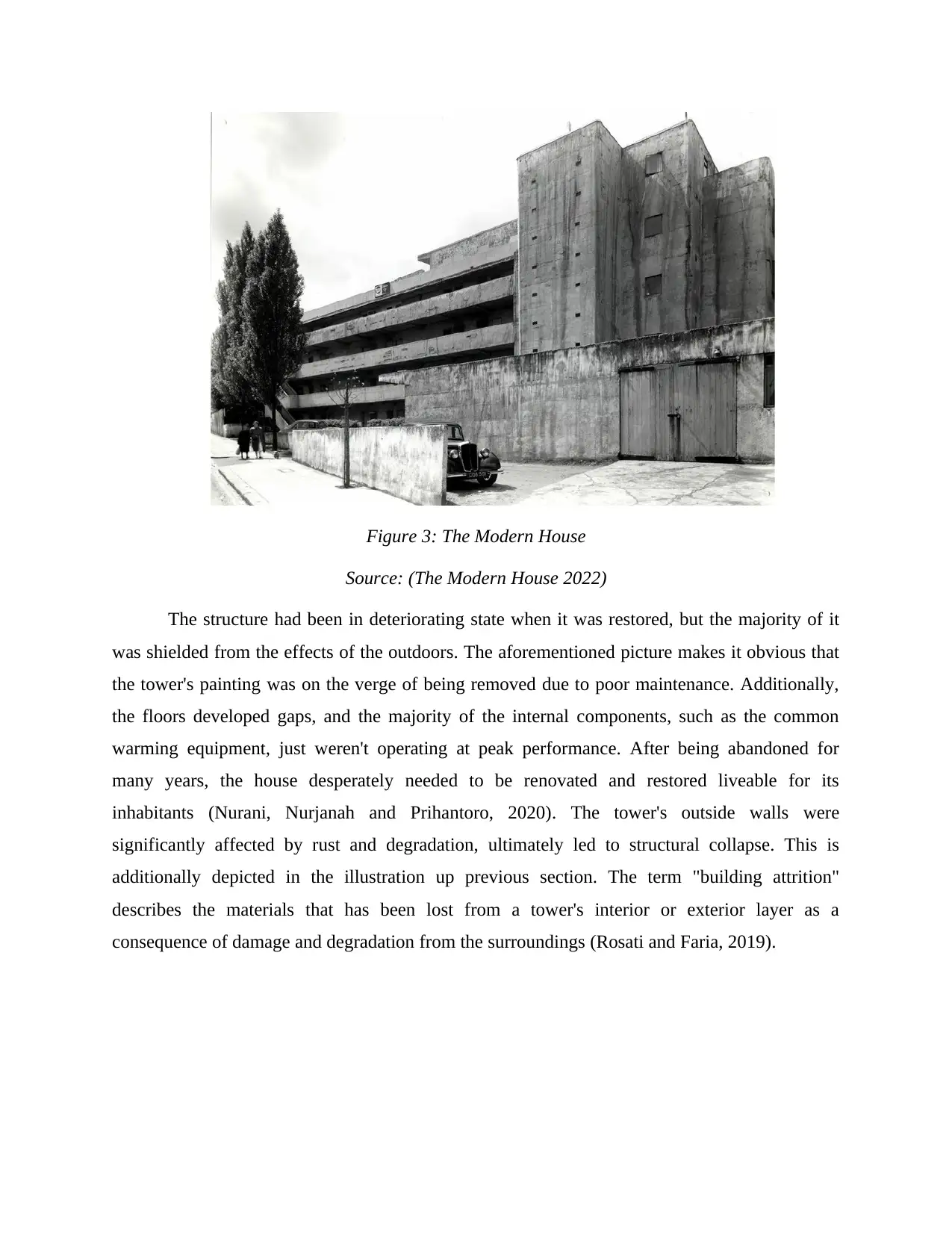
Figure 3: The Modern House
Source: (The Modern House 2022)
The structure had been in deteriorating state when it was restored, but the majority of it
was shielded from the effects of the outdoors. The aforementioned picture makes it obvious that
the tower's painting was on the verge of being removed due to poor maintenance. Additionally,
the floors developed gaps, and the majority of the internal components, such as the common
warming equipment, just weren't operating at peak performance. After being abandoned for
many years, the house desperately needed to be renovated and restored liveable for its
inhabitants (Nurani, Nurjanah and Prihantoro, 2020). The tower's outside walls were
significantly affected by rust and degradation, ultimately led to structural collapse. This is
additionally depicted in the illustration up previous section. The term "building attrition"
describes the materials that has been lost from a tower's interior or exterior layer as a
consequence of damage and degradation from the surroundings (Rosati and Faria, 2019).
Source: (The Modern House 2022)
The structure had been in deteriorating state when it was restored, but the majority of it
was shielded from the effects of the outdoors. The aforementioned picture makes it obvious that
the tower's painting was on the verge of being removed due to poor maintenance. Additionally,
the floors developed gaps, and the majority of the internal components, such as the common
warming equipment, just weren't operating at peak performance. After being abandoned for
many years, the house desperately needed to be renovated and restored liveable for its
inhabitants (Nurani, Nurjanah and Prihantoro, 2020). The tower's outside walls were
significantly affected by rust and degradation, ultimately led to structural collapse. This is
additionally depicted in the illustration up previous section. The term "building attrition"
describes the materials that has been lost from a tower's interior or exterior layer as a
consequence of damage and degradation from the surroundings (Rosati and Faria, 2019).
⊘ This is a preview!⊘
Do you want full access?
Subscribe today to unlock all pages.

Trusted by 1+ million students worldwide
1 out of 16
Your All-in-One AI-Powered Toolkit for Academic Success.
+13062052269
info@desklib.com
Available 24*7 on WhatsApp / Email
![[object Object]](/_next/static/media/star-bottom.7253800d.svg)
Unlock your academic potential
Copyright © 2020–2025 A2Z Services. All Rights Reserved. Developed and managed by ZUCOL.

